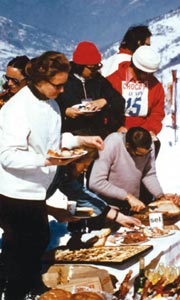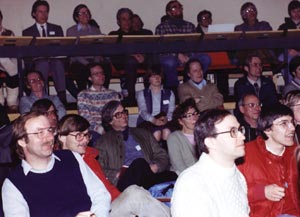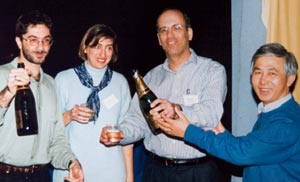“Theorists and experimenters must listen to each other.” This leitmotif inspired the first Rencontres de Moriond in 1966, and it was just as relevant at this year’s event.
From 5 to 19 March, 400 scientists from the four corners of the world gathered in La Thuile to discuss fundamental questions in high-energy physics and astrophysics, during four distinct one-week meetings. This was the 40th Rencontres de Moriond – an event that has grown from being a gathering of around 20 friends in 1966 to an annual institution for scientists everywhere.

In the early 1960s, scientific meetings in which theorists and experimenters discussed questions of mutual interest were rare. Even rarer were meetings in which participants of all ages talked to each other on an equal footing, in a climate insulated from day-to-day problems and far removed from the usual laboratory environment.
In 1965, Jean Tran Thanh Van, a young researcher at Orsay, decided to organize an unusual scientific meeting for January 1966. The subject itself – electromagnetic interactions – was not particularly unusual, but the organization was. The meeting was held in the French Alps in a group of chalets, with no catering help or assistance, few of the visual aids one associates with such meetings and, most importantly, without any telephone contact with the outside world. Tran Thanh Van was helped in this groundbreaking initiative by five colleagues: Bernard Grossetête, Fernand Renard, Michel Gourdin, Jean Perez Y Jorba and Pierre Lehmann.
This was not a conference or a school, but a gathering (“rencontre”) of minds. The name of what became a series of meetings reflects this original motivation. Held in Moriond village, the very first of the Rencontres de Moriond was a resounding success. The 20 participants included theorists and experimenters of all ages, from France, Italy (Frascati) and Germany (DESY). The time was well filled with fruitful but relaxed discussions, culinary experiments, skiing, and evenings spent listening to music performed by the scientists themselves.

The Rencontre was unusual in another respect. Half of the participants and organizers were young researchers, but their views and contributions were as significant as those of the senior members. At Moriond, all participants were equal, and none were more equal than others. Happily this tradition persists today.
For the past 39 years the meetings have not been held in Moriond, but they still take place in the mountains! The content has changed continuously, but the underlying Moriond spirit has taken on a life of its own, much to the surprise of Tran Thanh Van. Those original chalets used in 1966 soon became too small and the Rencontres moved to Courchevel, at the Hotel des Neiges, then wandered from hotel to hotel before finding a temporary home in Meribel in 1970, at the Lac Bleu hotel. Gradually, the Rencontres de Moriond became known as the annual fair of the high-energy physics community. Participants would go their separate ways, conduct their own research, then return to the annual Rencontres to show their latest work, find new collaborators and exchange ideas – and then continue their trek to new horizons. A core membership of more than 80 physicists began to meet annually.
In 1969, Tran Thanh Van felt that it was time to apply the idea of bridges within his discipline to bridges between disciplines. As a result, 1970 saw the addition of a biology meeting (founded by cell biologist Kim Tran Thanh Van) to the particle-physics meetings.
An evolving institution
During the decades that followed, the Rencontres gradually changed in character. From a one-week meeting, devoted essentially to one subject in high-energy physics, it expanded into a two-week conference with two basic topics in particle physics – electroweak and hadronic interactions – and a topic in biology. It became an annual “happening”, followed by physicists and biologists worldwide. It was a place to announce new discoveries, to discover the new directions that researchers were taking, and to forge new friendships and collaborations.

The Rencontres de Moriond became an institution, but the underlying motivation remained intact. Theorists mingled with experimenters; young researchers (postdocs and PhD students) were encouraged to present their work and talk with senior researchers as with colleagues and friends; even the most outrageous ideas had their place. The Rencontres were often the place for young scientists to present their first serious papers before a prestigious international audience, and a place to meet and listen to individuals before there was even a hint that they would one day win a Nobel prize.
Times changed, the pressure to publish rose and the number of participants grew, but the original convivial spirit of the Rencontres was an invariant from year to year. The early afternoon breaks were invariably devoted to skiing (for beginners and experts alike), but this never stopped the science. Tourists would often wonder who those strange people were, stopping on the pistes to talk about some recondite subject using an esoteric vocabulary, pausing to draw diagrams in the snow, and getting so involved in an arcane discussion on a ski lift that they would almost forget to get off.
Although science was always on our minds, on or off the snow, there was time to talk of other matters, to change the world, to make and listen to music. The scientific community includes a large number of excellent amateur musicians of all kinds, from singers to pianists and violinists, who would often show their skills after dinner around the bar. Sometimes a popular science talk would be organized for the general public of the resort, and these talks were always well received.
Science knows no barriers: a proton is a proton, in Switzerland, America or Russia. But the post-war world was a labyrinth of frontiers and walls, and the Rencontres de Moriond played a part in changing this stifling climate of political confrontation between the East and the West. Every effort was made to help and encourage Russian (and more generally Eastern European) scientists to come to the Rencontres, both to display their considerable scientific expertise – often unrecognised – and to learn about the latest advances in the West. This was a new and different kind of multidisciplinary work, which many years later would find an echo in the Rencontres du Vietnam. The annual Rencontres in the Alps was a peaceful haven where the best minds of hostile, inward-looking nations could meet, talk, exchange ideas, push back the frontiers of their discipline and dream of a happier future.
Changing times
As the 1970s drew to a close, participants at the Rencontres found themselves increasingly attracted by subjects such as atomic physics and astrophysics, which were beginning to encroach on the domain of high-energy physics. The Rencontres had begun as a forum for exchanging ideas in frontier science, and now, true to this spirit, Tran Thanh Van recognized that it was once again time to broaden the scope of the meetings.
In 1981 the Rencontres de Moriond Astrophysique was born. It ran in parallel with the now traditional high-energy and biology meetings, and was an annual event devoted to the study of the infinitely large. The Rencontres de Moriond had become a true interdisciplinary institution, where specialists in distinct disciplines could confront their very different views of the universe. There were accelerator experimenters, observers, theorists in particle physics, cosmologists and even experts in galactic evolution.
During its 40 year lifetime, the Rencontres de Moriond has welcomed more than 10,000 scientists of all ages and statures from across the world.
The Rencontres was thus restructured around three major centres of interest: biology, high-energy physics and astrophysics. But the rest of science was not neglected. As the 1980s gave way to the 1990s, new subjects, sometimes only marginally related to the regular topics, would start to make an appearance. Among these topics were gravitational physics, mesoscopic physics, the search for the fifth force and for new laws in physics, and tests of the limits of existing laws.
As with all successful enterprises, Moriond has evolved. There are now more subjects, more meetings, more participants and more administration! But the spirit and excitement of those early days remain unabated. No discipline is an island unto itself, and the programme of each meeting, whatever its nominal subject, emphasizes the essential unity of the scientific endeavour.
During its 40 year lifetime, the Rencontres de Moriond has welcomed more than 10,000 scientists of all ages and statures from across the world. The meetings represent an important date in the scientist’s calendar. Since 1993 they have been sponsored by the European Union under the euroconference system, and thanks to this financial help, many young researchers have been able to participate – helping to maintain the youth and vigour of the meetings.
Spin-off events
The Rencontres de Moriond has stimulated the creation of other meetings organized in the same spirit: the Aspen Winter Conferences (US) and the Rencontres de Physique de la Valée d’Aoste (La Thuile, Italy) are flourishing examples, where frontier science is conducted in a warm and convivial atmosphere. The Rencontres de Blois, in existence for 17 years, represents another development of the Moriond spirit; these meetings are explicitly multidisciplinary in character, the subject changing from year to year, and culture replaces skiing during the break time.
Most recently, the Rencontres du Vietnam, which started in 1993, has taken this idea even further, with the explicit aim of helping Vietnam, still a developing country, realize its great potential. These meetings offer a forum in which scientists from Asia and the West can meet, present their work and forge new collaborations.
Which brings us to the present day, and to this year’s Rencontres de Moriond. In March it welcomed 20 times as many participants as the first meeting, incorporated audiovisual techniques that were unheard of 40 years ago, and enjoyed instantaneous contact with the world through the Internet. On the programme was research into fundamental questions that had not even been asked in 1966. The impressive set of proceedings, covering several decades, emphasized that we are in the golden age of physics, and that science is more vigorous than ever.
But the unique spirit of those early meetings lives on. Of the 400 participants at the 2005 meeting, 57% were younger than 35; of the 350 papers presented, 80% were read by young researchers; 60% of the participants were experimenters or observers and 40% were theorists. Sandwiched between three hours of morning talks and another three hours of hard work in the late afternoon was that traditional break, in which science, snow and sky combine to create new and ever-changing patterns.
What has the Moriond spirit brought to the scientific community? Nobel laureate James Cronin had this to say at the 20th anniversary of the Rencontres: “The Rencontres de Moriond has had a profound effect on the way we communicate in particle physics. It is a format which is extensively copied. The first Rencontres I attended was in 1971. There I learned for the first time about the GIM mechanism from Glashow and Iliopoulos. By having informal conversation on the ski slopes and in the bar at night, one could really understand why charm is necessary… I shall remember… the opportunity to discern the genuine humanity of our colleagues from all over the world.”








